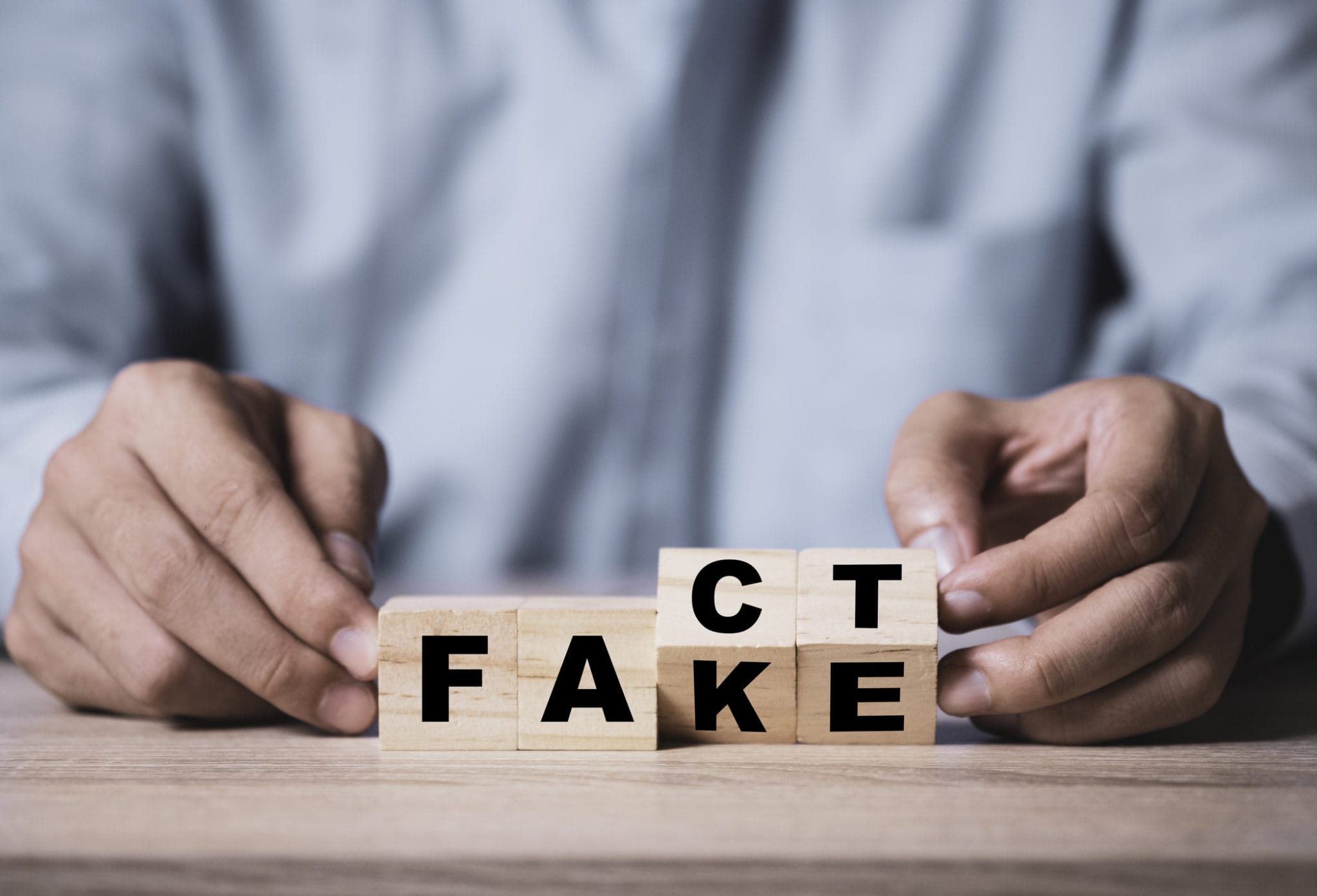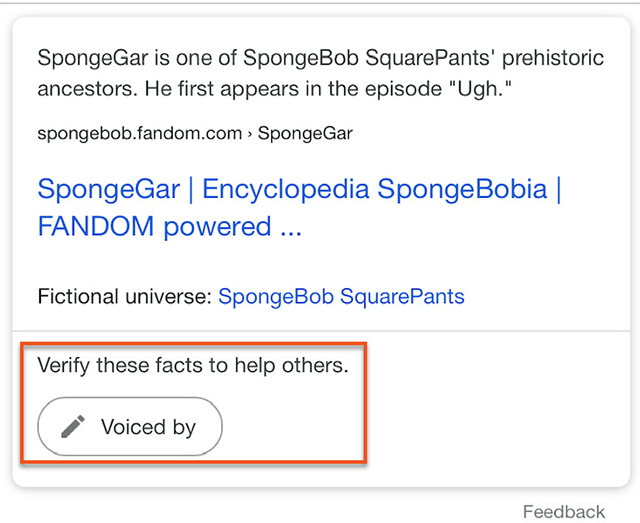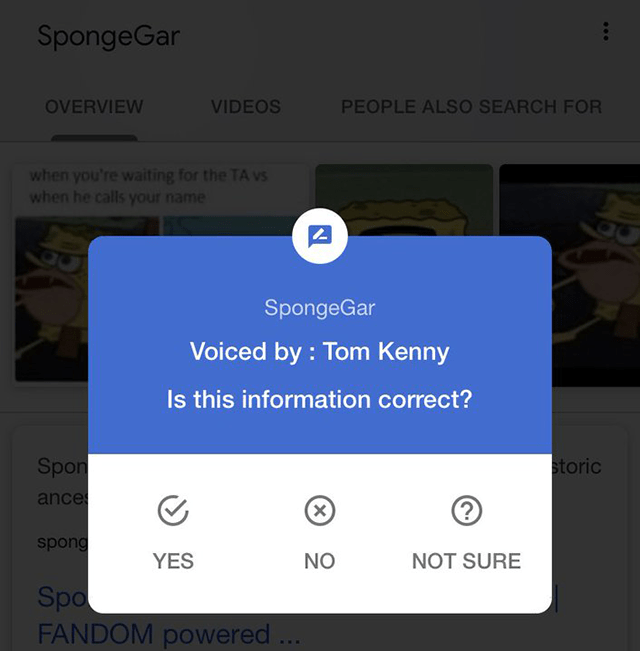
Google is now asking some searchers to “verify the facts to help others.” This feature is a new development – not available for all queries and not available for all searchers. Evidence at this point indicates that it appears to be an option for some knowledge panels.
Take a look at this example shared on Twitter:

Upon clicking the button, an overlay presents itself to allow you to indicate whether the information they have is correct.

There’s not much to indicate how widespread these searches are – or whether people will be able to manipulate Google’s results by blatantly providing it with wrong information. We’ll have to keep an eye on this to see how it pans out.
Overview
Fact Check Google Images
Fortunately, that’s not the only thing Google is doing to prevent the spread of misinformation on the internet. Back in June, they announced that fact check information was being added to Google Images.
When someone searches on Google Images, there may be a fact check label below the image thumbnail results. If you tap on one of the results to see a larger view, you’ll get a summary of the fact check that appears on the underlying webpage. Labels may show both for fact-checked articles about specific images, and for fact check articles that include that image in their story.
The fact check label appears on results that come from authoritative, independent sources across the web that meet Google’s criteria. These sources rely on ClaimReview which is an open method publishers use to indicate fact check content to the search engines.
Fact Check Labels in Search and News
Google has offered fact check in Search and News since 2017. The fact check label in Google News was made available everywhere and expanded into search globally in all languages. When you conduct a search that returns an authoritative result that contains that check from at least one or more public claims, the information is clearly displayed on the search results page. The snippet displays information on the claim including who made the claim in the fact check of that particular claim.
This information is not available for every search result, and there may be search results pages were different Publishers check the same claim while reaching different conclusions. The fact check does not belong to Google and is presented to allow people to make more informed decisions. Even though differing conclusions can be presented, it is still helpful for people to understand the level of consensus about a particular claim and have clear information on the sources that agree. As fact checks have become more visible in search results, people will be able to easily review and assess the fact checks to make their own informed opinions.
YouTube also uses the ClaimReview to surface fact check information panels in the U.S., Brazil, and India.
How You Can Fact Check Your Content for Google Searchers
The ClaimReview schema is part of the review schema. It is a fact-checking review of claims either reported or made in some creative work. It can be referenced via itemReviewed.
To add the fact check tagged to your content, there are some rules to follow. You need to build content around what users want, relying on trusted sources of information to back it up with facts, and be transparent as to where the thoughts came from. Your customers, prospective buyers, and fans will come to know your business and digital reputation as either one that provides the truth or stretches it.
Even though the fact-checking articles do not get any kind of special ranking boost, the visibility can boost traffic in terms of clicks, and help increase your conversions.
The fact check snippet references search words or phrases instead of being a cad for specific news. While aiming to offer valid sources of information, it includes a link to help readers develop their own views on the topic.
ClaimReview is a source label that helps to inform the search engines that use machine learning about the content of your website and offers insights that help them classify that content for rendering on the SERPs.
Google states: “We acknowledge the difficulty in characterizing different types of content in the rapidly changing publishing landscape, but we also hope to provide useful ways of helping users select what they want to read.”
The fact check label helps users to evaluate content before clicking on the link. The web page that contains the fact check data provides a link to the original data itself so that viewers can analyze it. Fact checks may provide the page quoted with a higher relevance than they might otherwise have. Google does not determine what is true or objective.
It’s important to note that fact checks are not guaranteed to be shown. The inclusion of fact check elements in search results is determined programmatically, based on things like how the search is phrased and the domain trust of the site that is referencing the fact. It also depends on whether the topic that has been fact-checked by someone participating in Google’s program, and if the necessary schema markup has been implemented on the page correctly.
For those who are curious, the full fact check tool, Fact Check Explorer, can be searched here, and APIs are available for developers.
Does Fact-Checking Influence Search Ranking?
If you, as a publisher, have fact-checked your content – either text or images – you will not see an increase in ranking just because you added the fact-checking schema to your site. The system is designed to provide users with the most relevant and reliable information available, including from the sources that provide the fact checks.
Contact us today to get the conversation started!









